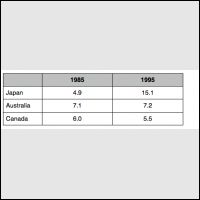The table gives the information about the proportion of tourists from three different countries (Japan, Australia, and Canada) who travelled overseas between 1985 and 1995, measured by millions. Overall, it is really important to noticeable that the number of tourists from Japan and Australia rose during 10 years, while the converse appeared to be true in the other.
Initially, we can see that Australian tourists were more likely to travel across the globe, reaching 7.1 million travelers, followed by Canadian and Japanese tourists who marked at 6 and 4.9 million at the same period.
Eventually, it is obvious that a significant increase occurred in the number of Japanese tourists who visited other countries at 15.1 million which overtaken the Australian tourists proportion to be the highest, while the proportion of tourists from Australia inclined slightly by around 100,000 travelers in the end of entire world. By contrast, the figure of Canada dropped steadily from 6 million travelers to 5.5 million in 1995. (162 words)
Initially, we can see that Australian tourists were more likely to travel across the globe, reaching 7.1 million travelers, followed by Canadian and Japanese tourists who marked at 6 and 4.9 million at the same period.
Eventually, it is obvious that a significant increase occurred in the number of Japanese tourists who visited other countries at 15.1 million which overtaken the Australian tourists proportion to be the highest, while the proportion of tourists from Australia inclined slightly by around 100,000 travelers in the end of entire world. By contrast, the figure of Canada dropped steadily from 6 million travelers to 5.5 million in 1995. (162 words)

Japan_tourists.jpg
